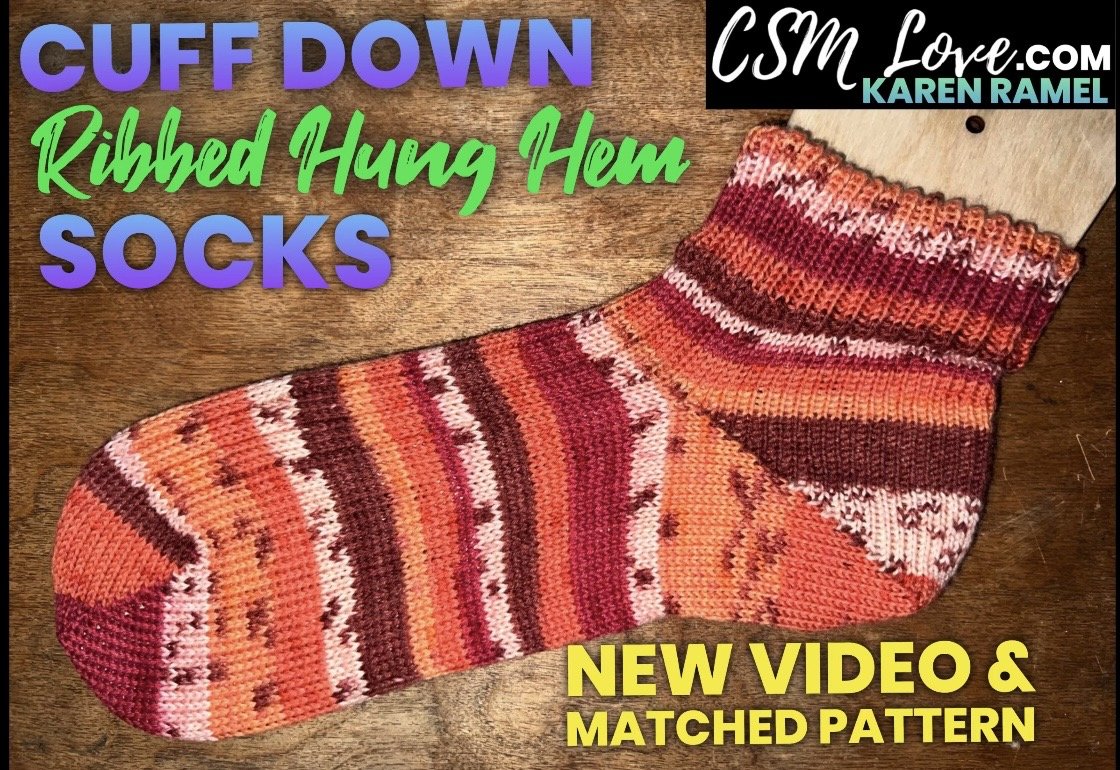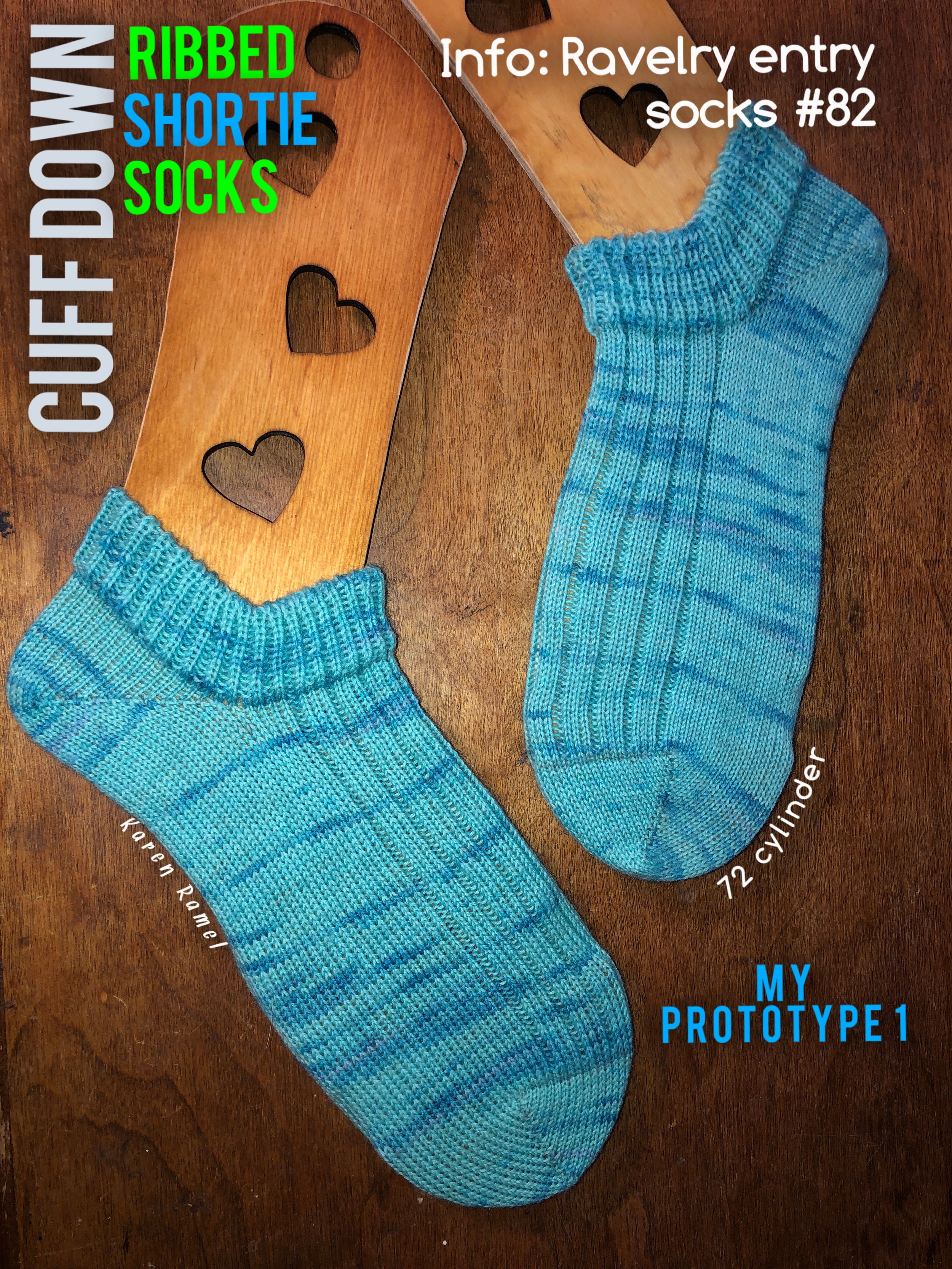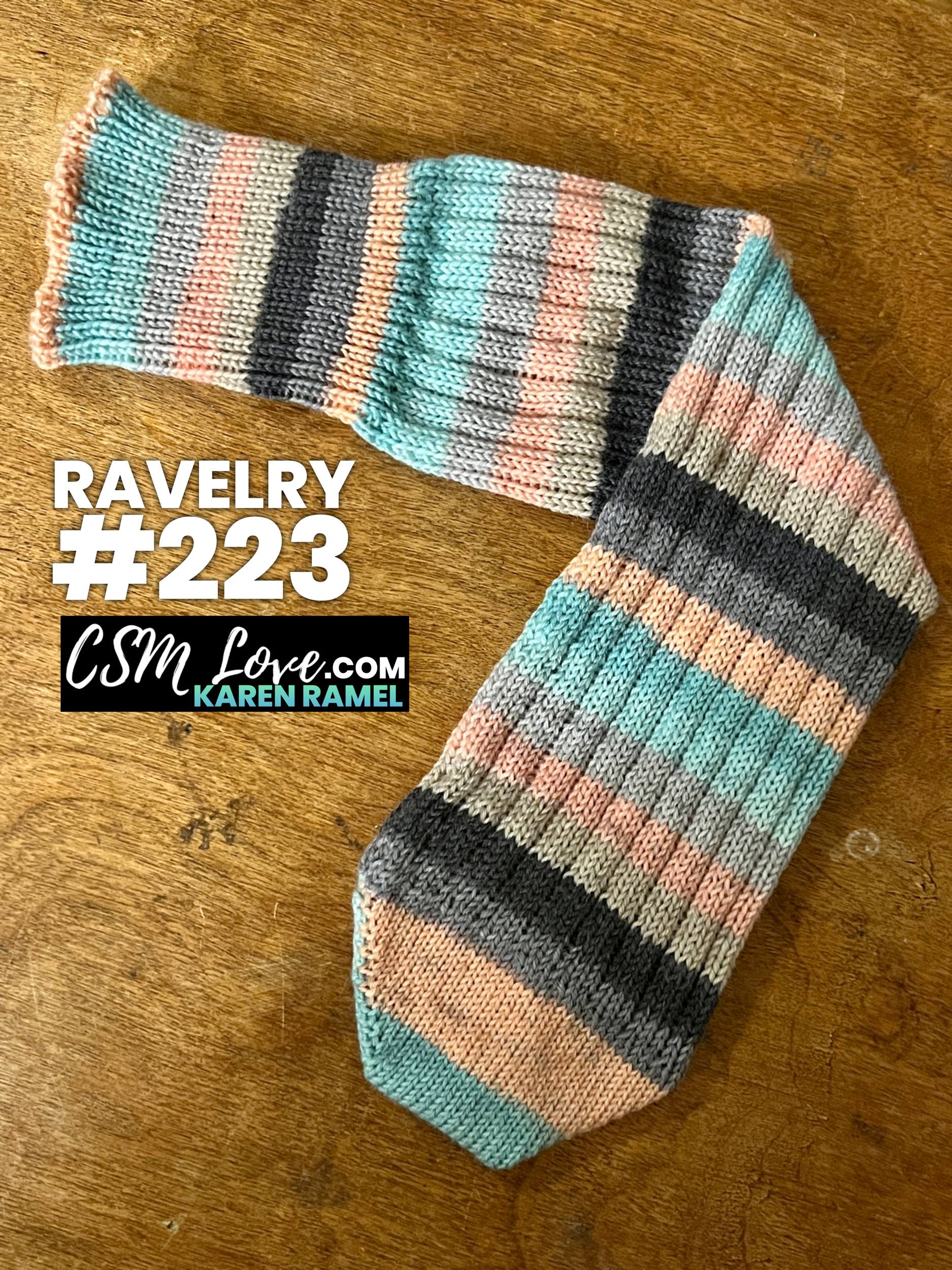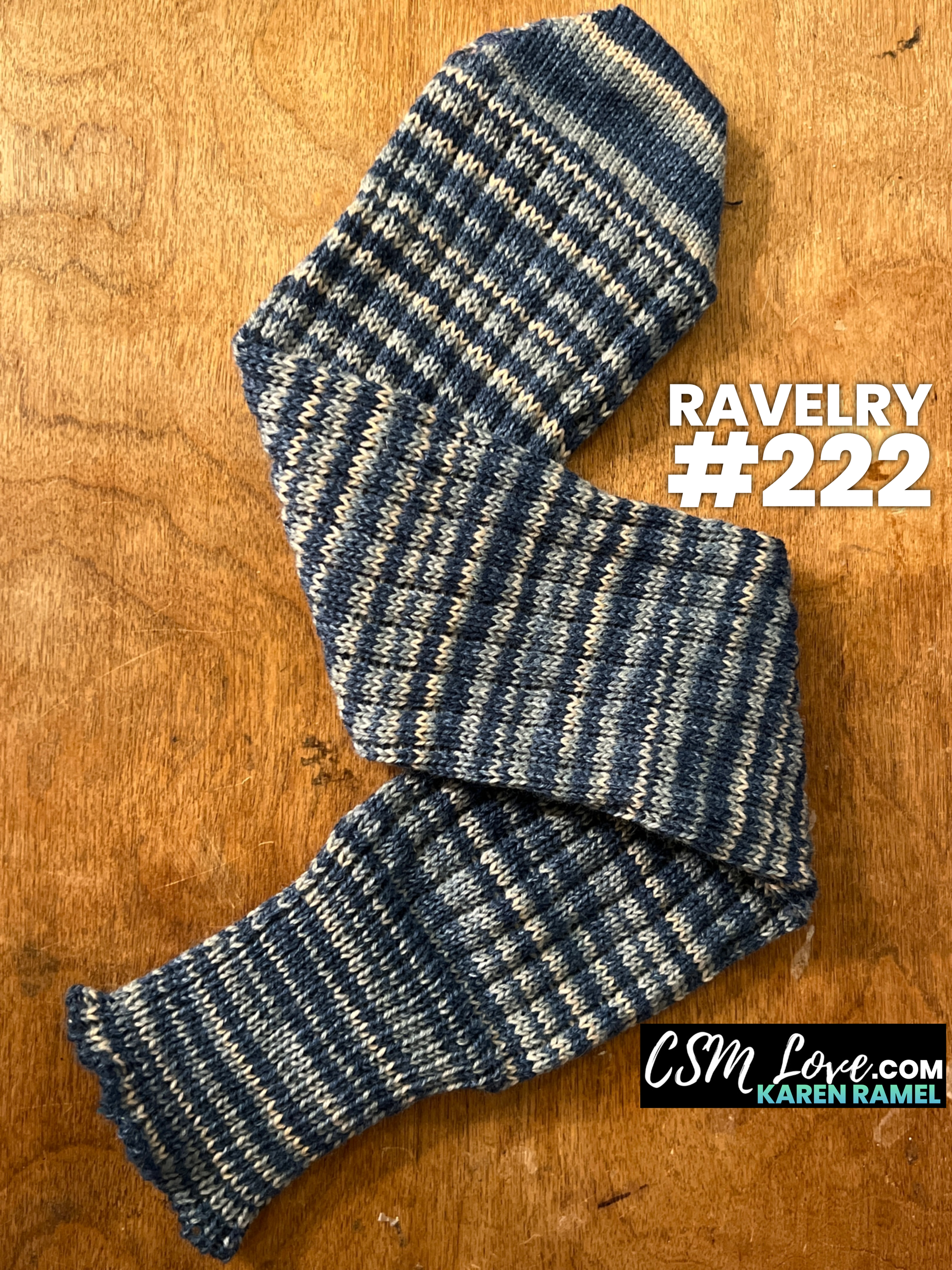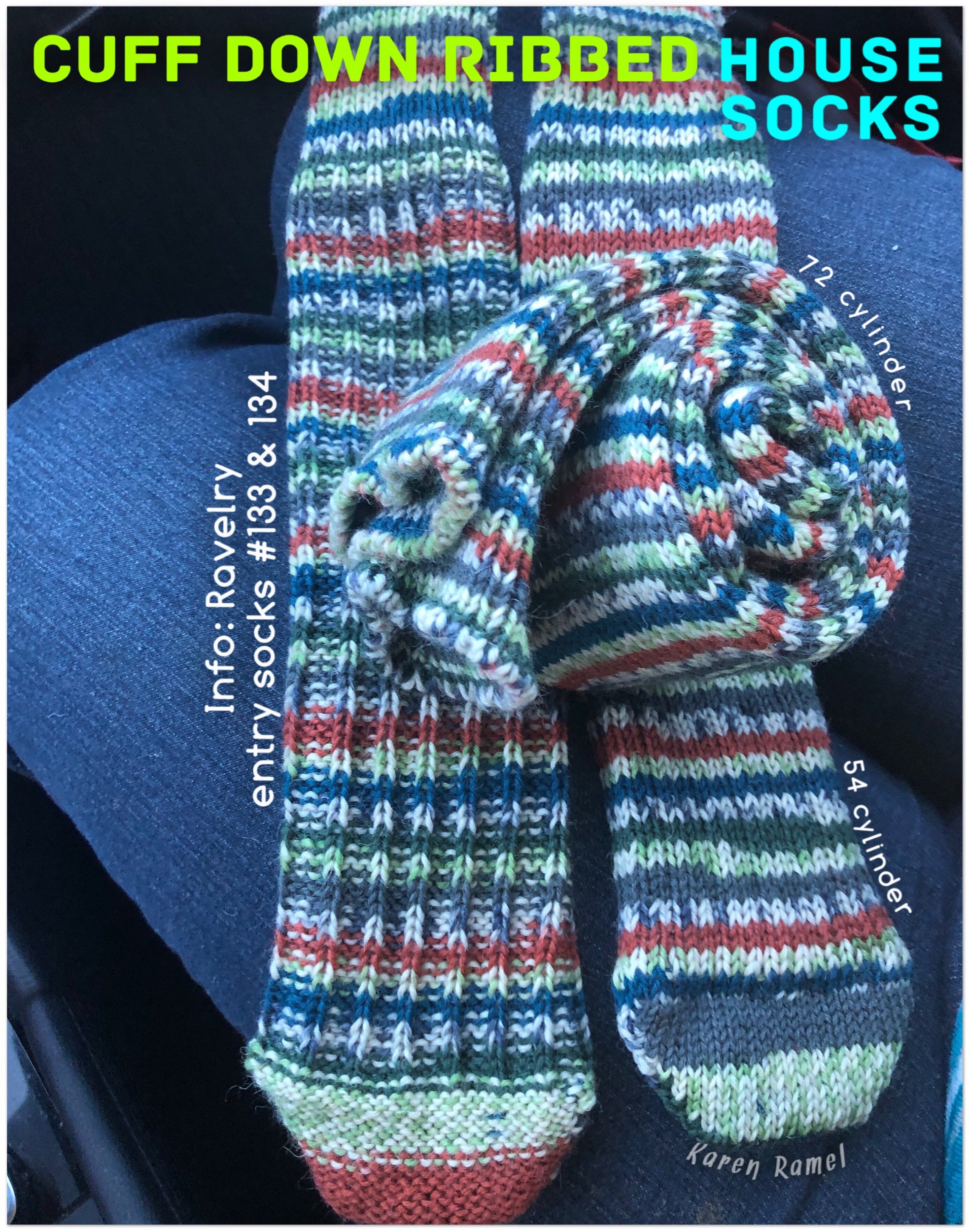Full Sock Cuff Down
Patterns and Videos
This page is being newly re-organized. Your patience is appreciated.
Also see the other pages on the VIDEOS AND PATTERNS menu.
If you prefer to look at all my videos off my website see my YouTube channel
Looking for more videos? See my CSM Video hotlist page which is an organized category list of other YouTube CSM videos.
A frequent new CSM user question we see is how to reduce sock ankle/heel holes?
(Magic two words: Interlock Stitch)
There are actually a variety of methods to reduce these (sometimes referred to working an interlock stitch). Here are three ONE) instead of starting heel at halfway point, we raise needles from the 2nd needle behind each of the 3 and 9pm cylinder positions. On the first heel row we lift two needles on right (one behind halfway and one in front), work the row then do the same on the left. Working the heel this way then creates an interlock stitch at the intersection. Or TWO) when working the heel, finish one row shorter then where you started=creates interlock of sort OR THREE I’ve heard mention of wrapping the first needle on both halfway points (I’ve not done this).
See any of the sock videos on this page to see examples of these. ONE is covered on the Cuff Down Ribbed Sock. TWO is covered on the Cuff down Mock Rib Shortie Sock. See https://www.csmlove.com/my-youtube-sock-videos
Unless noted, most CSM information has been around since the beginning of time (see the vintage CSM manuals for proof - half pitch setting to make adult hats etc), and only because some persons in the csm community dislike others to provide the sharing of clear knowledge by anyone other than themselves, I’ve had to state this here.
Want to see JUST HEEL INFO?
Please see this video and more on the TECHNIQUES page.
Please see the TECHNIQUES page for the HEEL area. This video and variety of easy tips and tricks and more heel designs in the works. :) This section also features the vintage manual approach to heel weights with a link also to weights on the CSM.
SOCKS - NO RIBBER NEEDED!
Don’t have or want to use your CSM Ribber? Not a problem! Socks can come in all designs with only your imagination being the limitation. As I feel socks built without mock ribbing (or real ribbing) just don’t have the same fit, socks shown here FOR NOW just feature mock ribbing in this section. Check it out.
CUFF DOWN
Cuff Down Mock Rib Shortie Sock
The shareable YouTube video is https://youtu.be/FY45JiqPga8
Introducing my Cuff Down Mock Rib Hung Hem Shortie Sock (yeah that’s a mouth full!)
I present a form fitted, mock rib, wonderful ankle sock alternative which works up speedy quick. This pattern starts with a hybrid 3x1 mock rib hung hem, a hanging of nearby stitches on both sides of newly added cylinder needles, 10 pre-heel rows, a deeper heel “no wrap method”, a reduced heel hole intersection issue by working one less final heel row, foot and same method toe. This pattern is an easy solution to a better fitting sock without needing to use a ribber.
Mock Rib Demo shareable YouTube video: https://youtu.be/uh2wL_kRh70
MAKE SMALLER SOCKS!
Basic Hung Hem Socks I created for a Kitchener Demo
Shareable link: https://youtu.be/Af7X9vLW20A
Adult socks can be made on cylinders 54-84 needle slots with fit determined by machine tension, fiber content and stretch and whether ribbing or mock rib is used.
But did you know that socks of any smaller size can easily be knitted on the machine with those same cylinders? From socks the size that would fit a Chapstick up until adult - making a Chapstick sized sock is worked flat and assembled afterward. Without using a smaller slot sized cylinder one can simply not load all the needles on the cylinder, apply the heel spring throughout and/or add lycra. OR one can buy a lower needle slot cylinder like I did below - a 40 slot cylinder. This cylinder has slightly wider slots and can better accommodate thicker yarn.
Very vintage Circular sock machines didn’t come in a variety of cylinder slot sizes, when simply just reduced an amount of needles used in a pattern over the circumference of the cylinder with the heel spring engaged.
This next video below is a silent real-speed video of my Legare CSM using a 40 slot cylinder, showing a simple cuff down sock with a 10 row hung hem. I make these to provide when teaching how to close the toes (Kitchenering) and sometimes finished versions to give away at introduction events. Project photos and further details on see Ravelry Sock listing #71 - username: Karenramel
A ONE MINUTE video is posted on my Instagram see HERE
The shareable YouTube link is https://youtu.be/Af7X9vLW20A
SOCKS USING THE RIBBER
I was asked how I currently work my preferred Cuff Down Ribbed Socks - all the steps I do and the finishing methods. I present this most current full video demonstrating a cast on with a universal bonnet, adding the Ribber to the machine, using Ravel Cord, starting my project sock yarn with the Anchor Yarn Tail (so I don’t have to sew in the yarn tail later) and how I use the Heel Spring.
I consider this the CSM Cuff Down Ribbed Sock +
If you were seeking written steps for this deluxe detailed video please refer to the original CSM Cuff Down Ribbed Sock video and matched written pattern available below. Certainly each technique applied over and above that (while shown in this newer video) is detailed on the Techniques page.
I will be adding subtitles as this is a audio-centric video covering cast on to sock finish (to close the toes of your sock off machine please see the kitchnering video on the non-sock page).
I announced this video with a quick silent version on Instagram.
The YouTube shareable link: https://youtu.be/zZKtAZRuok8
This live demo video covers the items below and more.
(The original) Cuff down ribbed sock with Ribber removal (Park & rest)
Shareable YouTube link: https://youtu.be/_yV2-Q7tGhg
Introducing my Cuff Down Ribbed Sock tutorial using the ribber - selvage (Ribbing, 2 Rows Knitting then Ribbing) utilizing 1x1 ribbing, 10 row pre-heel, heel hole intersection reduction through extra raised needles on first Left and Right Heel rows, the Heel/Toe (using method: “No Wrap”), and finally the ground breaking ribber removal with ribber needle park & lay method I propose - which is used prior to working the Heel/Toe. Going that extra quick step to remove the ribber before working the Heel then later, the Toe, allows for correction to any dropped stitches.
In the video I review each step from a sock anatomy, casting on with a Universal Bonnet and clear demonstration of each step. We also review how to use an elastic to lock the work onto the needles and how to fix any dropped stitches. I use a Legare 400 Circular Sock Machine with a 72 slot/needle Cylinder, 36 slot/needle Ribber Dial (although an equal 72 slot Ribber Dial would work as well). This video begins by reviewing our finished sock and goes from there. Join us! This video and pattern were presented to the public after much trial and testing in January 2020.
Unlike other videos out there I chose to pair this video with a FIVE page STEP BY STEP written file with photos to aid in following along in the video if one chooses.
| PDF of this written five page pattern | Ravelry Pattern | Ravelry project #65
A few of the many socks made in this pattern are below
Shareable YouTube video https://youtu.be/9Eb5BsFjQz0
| PDF of this five page written pattern | Ravelry Pattern | Ravelry project #218 | Some recent examples of this looks like worked up.
Want to just see the selvage worked up? See the Techniques page for the Selvages.
Cuff Down Ribbed Hung Hem Socks
Shareable video: https://youtu.be/SIoNvjB6OhI
Cuff Down Hybrid Universal Socks
These socks start with a 1x1 Ribbed cuff and switch to a 1x3 Mock Ribbed leg/foot and are built without a heel for a universal fit.
Shareable link: https://youtu.be/JRN_k1g-8Gc
Five page PDF printable pattern fully matched to the video | Shortcut pattern url - https://www.csmlove.com/s/csm_cdhybriduniversalsocks.pdf | Ravelry Pattern | Ravelry #231 | Ravelry Socks #222 | Ravelry Socks #223 | See the Ravelry Pattern link for older slightly different worked versions.
Some refer to as socks without heels as “House Socks”, “Bed Socks” or “Tube Socks”. This pattern is a Universal sized sock.
See examples I’ve made of this design:
Fully Ribbed versions are below
SOCK FIT AND SIZING
First I will share with you this amazing set of adjustable sock blockers which PERFECTLY size adjust to a US Women’s size per setting (US Women’s 8 = US Men’s 7). Don’t use US sizing? Determine the equivalent in your preferred sizing system and you’re set - just put your own labels.
MORE INFO on this sock blocker and my personal easy upgrades.
Now more about sizing. As you know sock sizing is more than sock foot length between heel and toe - it’s also diameter. All the above are affected by yarn used, machine settings, sock style (using heel spring throughout or in part or just on heel and toe, plain knitting, mock, ribbed, adding or reducing stitches with or without half pitch alignment).
Obtaining your desired outcome isn’t something anyone can predict for you due to the variables above however by you noting your machine settings etc and working through a sock you can adjust as needed.
For example. I can easily make a cuff down ribbed sock with mock or real ribbing on top of the foot on my 54 for my 8.5 foot but I prefer the foot feel using the same yarn and settings on my 72 for ease of donning the sock itself - modifying the machine setting and sock design as needed for my own preference. Cylinders with more needle slots create tubes of wider tubes. Certainly I could use my 54 with my ribber set at half pitch to add cuff stitches allowing for an easier sock donning but with my settings and yarn I prefer a simple approach with mock or real rib (depending on sock style - Shortie or not). My preference on rows and stitches per inch is to work at a certain gauge for fabric feel.
If you were meaning children sizes we could remove needles in an even pattern (reducing diameter) and apply the heel spring throughout with or without Lycra (I don’t use Lycra).
For further information on sizing etc please see the quick look up INDEX page (located under the MISC menu on the main page) and look up the category you seek (it’s alphabetical). Also see the Supplies I like page. See more of My Ideas and Upgrades.
KITCHENERING (Closing the Toe) - see the Techniques page
HOW TO WORK DIFFERENT COLORS INTO A SOCK - see the Techniques page
Silent Videos?
I’ve been asked recently why some of my newer videos are silent.
This is my reply: A silent film is easier for me due to ambient noise (especially when so many fans are running on a hot day). I understand at an audio video helps English speakers however in the beginning, I also felt a silent video is more focused, can help English as a second language persons and can help those with hearing difficulties. I am not a fan of chatty videos. But I do appreciate that an audio video does help - I will see about adding audio in the final edit of my next video.
Feel like being inspired by what I’ve created?
See MY SCRAPBOOK page - connected to my Ravelry projects. Click on images to see all sock detail/steps.
Want to see what I’m up to? See my INSTAGRAM | Have a question? EMAIL ME! karenramel AT yahoo.com
Need HELP? SEE THIS PAGE






